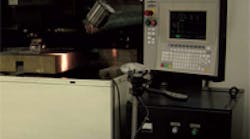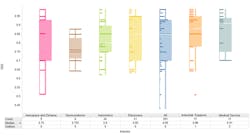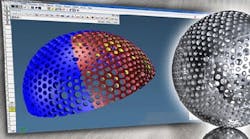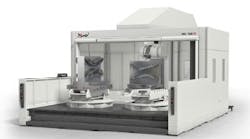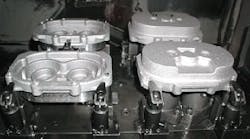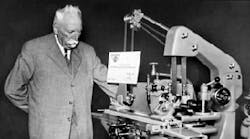Watching a machine run via webcam may not be as compelling as the evening news, but for many shops, visually monitoring machines has become an important practice in improving manufacturing operations.
As a manufacturing tool, cameras that can be accessed remotely are growing in popularity because they provide shops an added level of confidence when they are running machines unattended. Cameras also help to streamline workflow, and can even help to win new customers.
Suburban Tool & Die (www.suburbantool.com) uses multiple portable webcams that are mounted on tripods to monitor its unattended EDM and milling operations. The cameras are moved as needed when jobs change.
Employees can access the cameras and monitor machines whenever they want and from remote locations by logging onto the shop’s computer system through the Internet. That allows them to check job progress 24/7.
Other people also can watch the shop’s cameras by logging onto a website that is separate from the one employees use. In addition, through that separate site, potential customers can use the cameras to tour Suburban’s facility.
“The employees that use the cameras on a daily basis love the system because it gives them the flexibility to create their own schedules when it comes to jobs running unattended,” Jeff Rzepka, manufacturing manager at Suburban Tool & Die in Erie, Pa., said.
He explained that the shop works to accomplish goals, not to put in 40 hours of work a week, or 8 hours a day, or 6 hours on a Saturday. For some jobs, employees can leave work, monitor the machine, and come in only when they are needed after a job starts running.
Rzepka said that has reduced labor costs and also has improved throughput. In turn, the shop’s deliveries are faster, and it has been able to lower its prices.
Before it installed its webcam system, toolmakers at Suburban Tool & Die came in on Saturdays for what was typically a 6-hour shift to either change an electrode on the shop’s Makino Ram EDM or to set up new jobs on its Makino milling machines. Often, much of that shift would see the toolmakers sitting and waiting for a job to be finished or an electrode to need changed, and if the change or new setup didn’t happen during those six hours, the shop lost valuable run time for the rest of the weekend.
Today, machines at Suburban Tool & Die often run entire weekends, and require only a few hours of labor, and those hours are determined by toolmakers monitoring the operations remotely.
The shop designs and manufactures custom molds, and some of the EDM electrodes it uses can weigh as much as 150 lb. Those electrodes must be loaded manually because they are too big for an automatic toolchanger.
Rather than being at the shop all day Saturday anticipating the change time, toolmakers can view machines from home to pinpoint exactly when they need to come in to do the change.
“The cameras generate an action plan. If an operator sees there’s something amiss, he comes in and takes care of it,” Rzepka said.
Form G Tech Co. (www.formgtech.com) in Troy, Mich., also runs a lot of work overnight and unattended. Form G Tech uses 10 of its 12 webcams to get the whole picture of its operations, according to Jimmy Lumani, president. Form G Tech is a tool and die shop that serves cold heading companies.
Lumani said his guys train cameras on the shop’s Makino wire and Ram EDMs to ensure that the machines are running. The cameras tell shop workers if there is an alarm or if a machine needs wire and lets them check on how jobs are set up and if parts are properly loading into the machines.
Form G Tech also monitors its cameras remotely through the Internet and can zoom in and out. Lumani said he used that ability once to look at a part print and to answer a customer’s questions about a job while he was overseas, tapping into the shop’s system via the Internet.
“My guys have no problems with the cameras. They realize they are added insurance for our overnight operations,” Lumani said. He also pointed out that the cameras complement the shop’s remote machine-control system.
Eighty percent of the time, it is potential customers who are logged onto the webcam at Advance Turning & Manufacturing Inc., a 2006 American Machinist 10 Best Shop in Jackson, Mich.
The shop installed the camera primarily as a marketing tool and secondarily as a processtracking tool.
Frank Lusebrink, vice president of Advance Turning, said his shop often wins jobs because potential customers use the webcams to tour its facility and to see its capabilities first hand.
Advance Turning installed a webcam over one of its production cells and linked it to the shop’s webpage (www.advanceturning.com) to make this live-visit experience available to more potential customers and to save potential customers the time and money of traveling to the shop.
During on-line tours, potential customers follow a tour guide that manipulates the camera to show them around the work area. Visitors then can take control of the camera to navigate around the work cell and to zoom in and out to get closer looks.
Separately, when issues of shop procedure arise, Advance Turning can use the camera to record the flow of operations for its manufacturing cells. The stationary camera can be navigated to record three different cells.
Recordings can be replayed at a fast speed to allow the shop to watch the events of a day in an hour’s time. The shop has had everyone involved with a specific machining cell watch recordings to figure out where procedural adjustments needed to be made.
“When a new job starts, operators should have the tools and support they need within four steps. If we see, on the recording, that the operator had to leave the cell, we know he didn’t have everything he needed for the job, and we make sure the problem is taken care of,” Lusebrink said.
He added that the camera system is not a “Big Brother” to the operators, nor is it a performance-rating tool.
It is there to make sure the shop’s cell operations flow the way they should. In fact, the shop tries to record operations in a machining cell every six months and more frequently if someone brings up a problem.
“In some ways, employees can interpret cameras as a violation of the trust relationship. So, anytime you stick a camera in your shop, you have to set the ground rules as to what you are and are not going to use it for,” Lusebrink said.
Cameras and controls
Manufacturing is no longer a machinist leaning over a machine and adjusting it by hand.
It has evolved to become a computer-controlled, automated process for getting parts out the door 24 hours a day, seven days a week.
Shops that have embraced the concept of lights-out manufacturing need to see and to control what’s going on, Tim Zott, chief executive officer of Remote Machining Inc. (www.remotemachining.com), pointed out. Remote Machining is located in West Bloomfield, Mich.
Zott said that webcams let shops see what’s going on with their machine tools, but they are passive systems.
That is the reason that many shops pair webcam systems with systems that allow them to control a machine tool remotely. Remote Machining does that.
“Anything you can do dynamically at the control without stopping the machine can be done remotely over the Internet with our system. However, all mechanical interlocks are disabled in accordance to OSHA’s remote standard, meaning a shop can’t start or stop a machine from a remote location,” Zott said.
Remote Machining’s system offers remote control and monitoring of any kind of CNC machine, including the current line of Makino (www.makino.com) machines.
For some machine brands, the system is software, and for others, it’s strictly hardware. Zott said that it depends on the application.
Aaron Miller, owner of ALM Technologies LLC (www.almtech.net), said some shops want webcams placed inside machine tools so they can see parts being cut. Miller said keeping the camera clean and its lens clear becomes a challenge when his company has such an installation. ALM Technologies is a networking company that also installs visual monitoring systems.
The company addresses the challenge of in-machine monitoring with off-the-shelf, waterproof cameras that have true lenses located behind a protective glass. Shops occasionally have to spray the protective lens with machine coolant to keep it clear.
Miller said the cameras typically are connected to a DVR to allow a shop to record machining operations.
“Makino has been putting cameras inside its machines for a long time as a display tool that operates as a closed-circuit TV system. We just took the concept a step further by adding the ability to view the cameras remotely,” Miller said.
Shop Goes to the Video TapeJobshop M.R.S. Machining (www.mrsmachining.net), a 2007 American Machinist Top 10 Shop, used to photograph its setups and tooling for its repeat jobs as a guide for its machinists.
However, even with photos as guides, setup times still varied among the different machinists, so the shop decided to digitally record two machinists setting up the same job on turning centers.
What the shop discovered after watching the videos was that each machinist followed a different setup procedure.
For example, one loaded all his tools then set them, and the other put his tools in one at a time.
To remedy such setup discrepancies, M.R.S. Machining loaded videos into the computers that each machinist has at his workcell. The videos show the quickest setup procedures for repeat jobs.
Now, everybody is on the same page for repeat job setups, and the shop gains a more accurate estimate of how long a job will take because the setup times aren’t varying from one machinist to the next.
Machinists at M.R.S. Machining consider the videos a useful tool.
“We went into this (video recording) with the understanding that we just wanted to learn from the recordings,” Matt Guse, manufacturing engineer, vice president and owner of M.R.S. Machining, stated. M.R.S. Machining is located in Augusta, Wis.
Besides job setups, the shop uses video for machine maintenance, including re-aligning turning center turrets. Previously, only a few machinists at the shop knew the procedures for re-aligning turning center turrets, and if they were busy, operators had to wait while their machines sat idle.
M.R.S. Machining set up its camera, recorded the procedure and loaded the video into its workcell computers. Operators now can perform the procedure on their own as they watch the video for step-by-step instruction. <<
